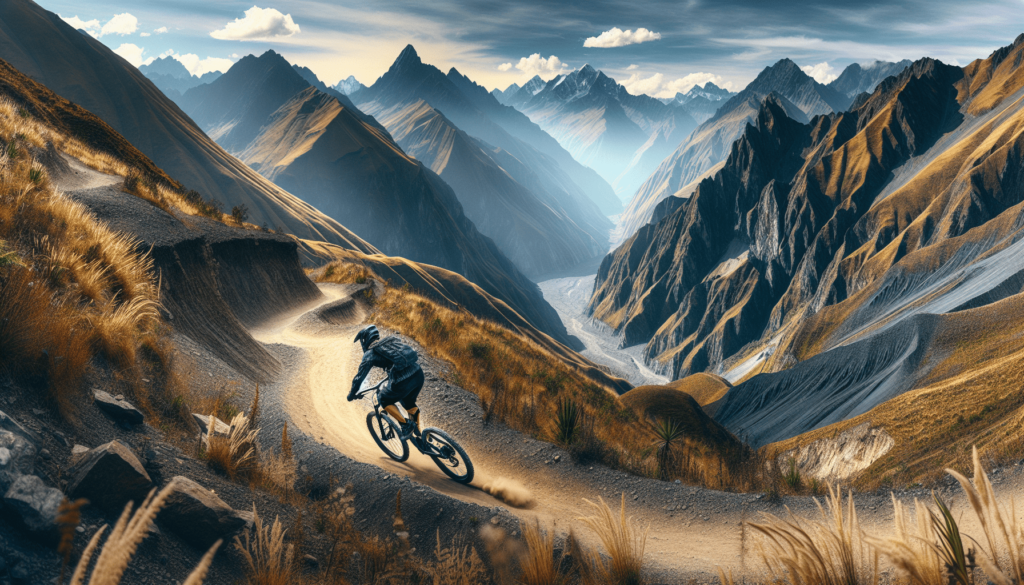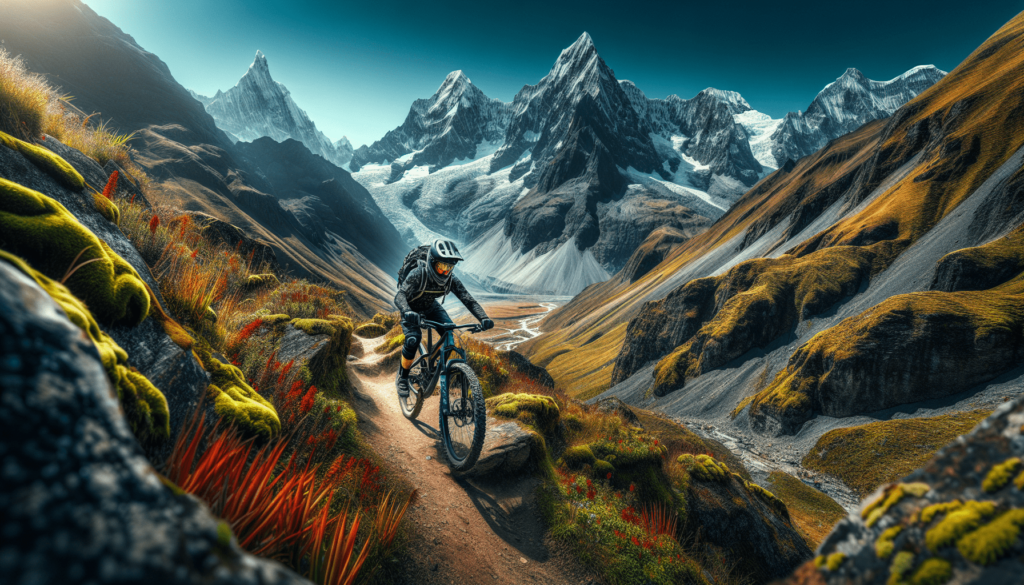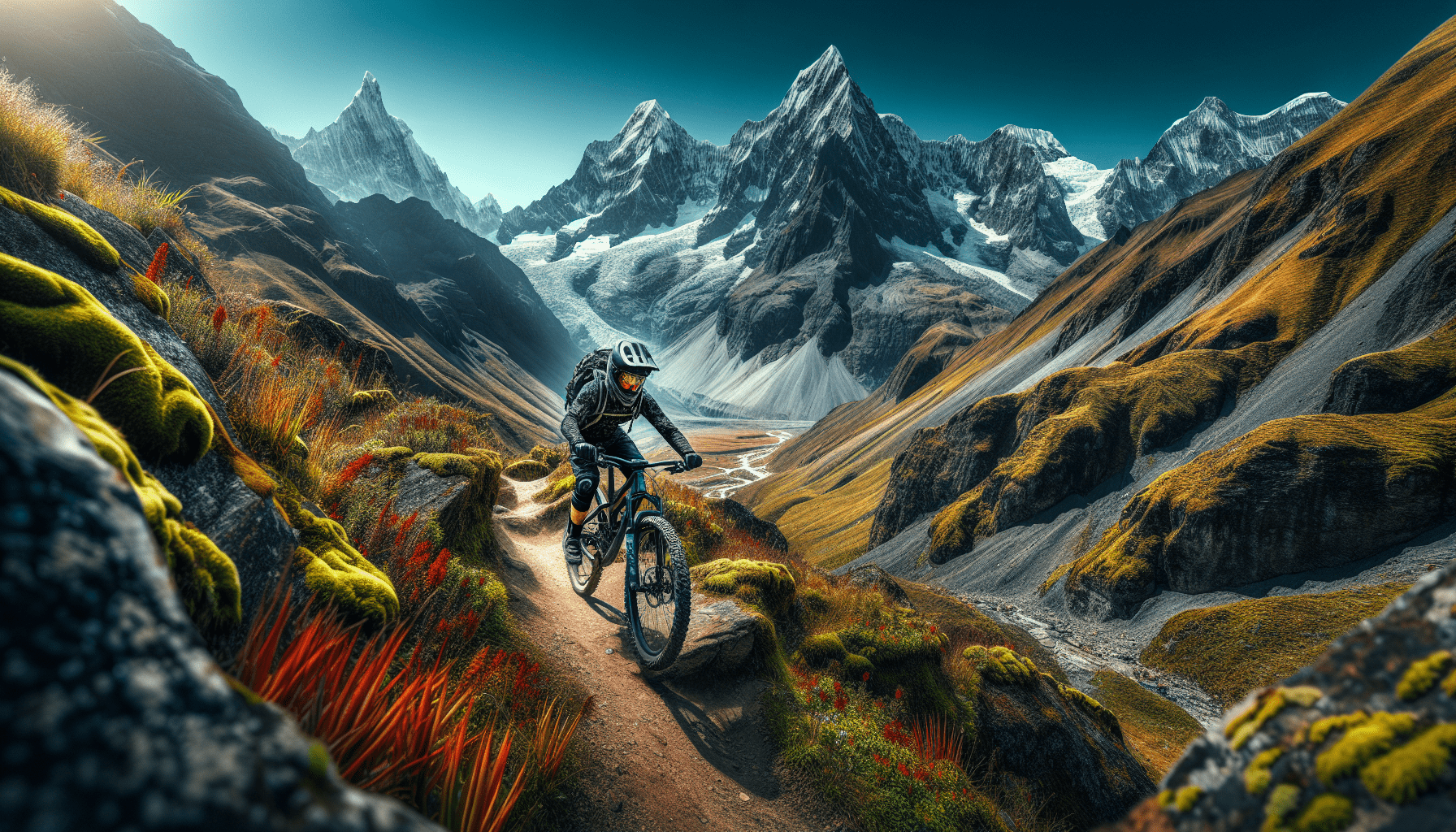Picture yourself soaring down rugged mountain trails, the sun warming your skin and the wind whipping through your hair. In this exhilarating article, we invite you to embark on an unforgettable journey through the majestic Andes mountains, exploring the world of mountain biking. Get ready to conquer thrilling descents, navigate challenging terrain, and immerse yourself in the breathtaking beauty of one of South America’s most iconic landscapes. This is your ticket to an adrenaline-fueled adventure like no other, where the Andes become your playground and every twist and turn brings a new opportunity for excitement. Are you ready to discover the thrill of mountain biking in the Andes? Let’s hit the trails and embark on the ride of a lifetime.

What is Mountain Biking
Mountain biking is a thrilling outdoor sport that involves riding specially designed bicycles called mountain bikes off-road. Unlike road cycling, mountain biking takes place on unpaved paths, rugged terrains, and natural trails, giving riders the opportunity to explore and challenge themselves in diverse natural environments. It combines elements of endurance, skill, and adrenaline, making it an exciting and dynamic activity for outdoor enthusiasts.
Definition
Mountain biking is a form of cycling that typically takes place off-road, often on mountainous or hilly terrains. It includes various disciplines such as cross-country, downhill, enduro, and trail riding. The sport requires specialized bicycles that are equipped with features like suspension systems, knobby tires, and strong frames to handle the demanding conditions of off-road riding.
Types of Mountain Biking
There are several types of mountain biking, each offering a unique experience and catering to different skill levels and preferences.
-
Cross-Country (XC): This is the most common type of mountain biking and involves endurance riding on a variety of terrains. XC trails are typically a mix of climbs, descents, and technical sections, and riders compete to complete the course in the fastest time.
-
Downhill: Downhill mountain biking is all about speed and adrenaline. Riders navigate steep descents, jumps, and drops, often in purpose-built bike parks or trail systems. Protective gear like full-face helmets and body armor is crucial for this high-intensity discipline.
-
Enduro: Enduro mountain biking combines elements of both cross-country and downhill riding. It consists of timed downhill sections interspersed with untimed uphill or cross-country stages. Enduro races can last several hours and test riders’ technical skills and endurance.
-
Trail Riding: Trail riding is the most versatile and accessible form of mountain biking. It involves riding on natural trails, ranging from smooth singletracks to more technical and challenging routes. Trail riding allows riders to explore scenic landscapes and enjoy the thrill of off-road biking at their own pace.
Why Choose the Andes for Mountain Biking
The Andes mountain range, stretching along the western coast of South America, offers an awe-inspiring backdrop for mountain biking adventures. Here are a few reasons why the Andes should be at the top of your list for your next mountain biking destination.
Scenic Beauty
The Andes are renowned for their breathtaking landscapes, making it a paradise for nature lovers and outdoor enthusiasts. As you pedal through the mountainous terrain, you’ll be treated to panoramic vistas of towering peaks, deep valleys, shimmering lakes, and lush green forests. The diverse and picturesque scenery of the Andes provides an unparalleled setting for a memorable mountain biking experience.
Challenging Terrain
For those seeking an adrenaline rush and a physical challenge, the Andes offer a wide range of terrain options. From rocky trails that wind through rugged mountainsides to steep descents that demand technical skills, the Andes have it all. Riders can push their limits and improve their riding abilities as they navigate the varied landscapes and conquer the thrilling trails.
Cultural Experience
Alongside the natural beauty, the Andes region is rich in history and culture. Mountain biking in the Andes allows you to immerse yourself in the local traditions, interact with welcoming communities, and explore ancient archaeological sites. You can witness the vibrant culture of indigenous tribes, indulge in traditional cuisine, and learn about the region’s fascinating history. The combination of outdoor adventure and cultural immersion makes mountain biking in the Andes a truly unique experience.
Best Time to Go Mountain Biking in the Andes
When planning your mountain biking trip to the Andes, it’s essential to consider the weather and tourist seasons to make the most of your experience.
Weather Considerations
The weather in the Andes can vary significantly depending on the region and altitude. It’s always advisable to check the weather forecast before your trip and pack appropriate gear accordingly. The Andes experience rainy seasons, and certain trails may be impassable or dangerous during heavy rainfall. Generally, the dry season, which varies across the region but typically falls between May and September, is considered the best time for mountain biking, as the trails are more stable and the weather is more predictable. However, it’s still essential to be prepared for sudden changes in weather.
Avoiding Peak Tourist Seasons
To fully enjoy your mountain biking adventure in the Andes, it’s advisable to avoid peak tourist seasons. These periods can be crowded, making it harder to secure accommodations and enjoy the trails without excessive congestion. Peak tourist seasons in the Andes vary depending on the country and specific regions. Researching and planning your trip during quieter times can enhance your overall experience by allowing you to immerse yourself in the natural beauty of the Andes with fewer distractions.

Must-Have Gear for Mountain Biking in the Andes
Before embarking on your mountain biking journey in the Andes, it’s crucial to have the right gear to ensure your safety and comfort throughout the adventure.
Mountain Bike
Choosing the right mountain bike is essential for a successful and enjoyable ride. Consider the type of terrain you’ll be encountering and choose a bike with a suitable suspension system, tire width, and frame material. It’s recommended to opt for a bike with good durability and maneuverability, as the Andes can offer challenging terrains and technical sections.
Helmet
A high-quality helmet is an absolute must when mountain biking, and the Andes are no exception. Protecting your head is vital, especially when riding in rugged and unpredictable environments. Make sure your helmet fits properly and provides adequate coverage to ensure maximum safety.
Protective Gear
To minimize the risk of injuries, wearing additional protective gear is highly recommended. Depending on your riding style and preferences, consider investing in knee and elbow pads, gloves, and a sturdy pair of mountain bike shoes. These protective measures can greatly enhance your safety and confidence while tackling the diverse terrain of the Andes.
Extra Clothing and Gear
The weather in the Andes can be unpredictable, so it’s important to carry extra clothing and gear to prepare for any changes. Pack breathable and moisture-wicking clothing, as well as a waterproof jacket in case of rain. It’s also advisable to bring a small backpack to carry essentials such as water, snacks, a first aid kit, and tools for any unexpected mechanical issues.
Preparation and Training for Mountain Biking in the Andes
Preparation and training are crucial for a successful and enjoyable mountain biking adventure in the Andes. Here are a few key aspects to consider before embarking on your trip.
Physical Fitness
Mountain biking in the Andes can be physically demanding, especially when riding on steep climbs or enduring long hours in the saddle. Prioritizing your physical fitness through regular exercise, strength training, and cardiovascular workouts can greatly enhance your endurance and overall performance on the trails. It’s essential to set realistic goals and gradually increase your fitness level to ensure you’re adequately prepared for the challenges that await in the Andes.
Altitude Acclimation
Many mountain biking routes in the Andes are located at higher elevations, which can pose challenges for riders who are not acclimated to the altitude. Spending a few days acclimating to the altitude before embarking on challenging trails can help minimize the risk of altitude sickness and increase your comfort while riding. It’s important to listen to your body, stay hydrated, and take breaks as needed to adapt to the altitude gradually.
Technical Skills
Building and refining your technical riding skills is essential for tackling the diverse terrain of the Andes. Familiarize yourself with the specific techniques required for handling steep descents, navigating rocky sections, and maintaining control on uneven surfaces. Consider taking mountain biking lessons or practicing on local trails to improve your bike handling skills and boost your confidence before taking on more advanced routes in the Andes.
Popular Mountain Biking Routes in the Andes
The Andes offer a plethora of incredible mountain biking routes that cater to riders of all skill levels. Here are three popular routes that showcase the diverse beauty and thrill of mountain biking in the Andes.
The Death Road, Bolivia
Known as one of the world’s most dangerous roads, the Death Road in Bolivia offers an adrenaline-pumping mountain biking experience like no other. Starting from La Paz and descending towards the Yungas region, riders navigate a narrow and treacherous route along dramatic cliffs and through misty rainforest. This iconic route attracts thrill-seekers from around the world and promises an unforgettable adventure in the heart of the Andes.
The Inca Jungle Trail, Peru
For those seeking a blend of mountain biking and cultural exploration, the Inca Jungle Trail in Peru is an excellent choice. This multi-day route combines mountain biking, trekking, and even zip-lining, culminating in a visit to the iconic ancient city of Machu Picchu. Riders will enjoy panoramic views of the Andes, pedal through lush valleys, and experience the rich history and culture of the Incas.
The Carretera Austral, Chile
The Carretera Austral in Chile is a legendary route that stretches over a thousand kilometers through remote and pristine wilderness. This epic journey is ideal for riders looking to immerse themselves in the untouched beauty of the Andes. The route offers breathtaking views of towering mountains, shimmering lakes, and picturesque fjords, making it a paradise for nature lovers and adventure seekers.
Safety Tips for Mountain Biking in the Andes
While mountain biking in the Andes can be an exhilarating experience, it’s crucial to prioritize safety. Here are some essential safety tips to keep in mind:
Ride with a Group
Riding with a group is not only more fun but also enhances safety. Group rides allow for mutual support, especially in case of emergencies or technical difficulties. Additionally, riding with experienced riders can provide valuable guidance and improve your skills.
Stay Hydrated and Nourished
The high altitudes and physical exertion of mountain biking can lead to dehydration and fatigue. It’s essential to carry an adequate supply of water and energy-rich snacks to stay hydrated and nourished throughout your ride. Remember to drink regularly and eat small, frequent meals to maintain your energy levels.
Be Aware of Altitude Sickness
Altitude sickness is a real concern when mountain biking in the Andes, especially for riders who are not acclimated to higher elevations. Symptoms may include headaches, fatigue, nausea, and shortness of breath. If you experience any discomfort, it’s important to descend to a lower altitude and seek medical attention if necessary. Monitoring your body’s response to altitude and taking appropriate breaks can help prevent altitude-related issues.
Guided Tours vs. Independent Mountain Biking in the Andes
When planning your mountain biking adventure in the Andes, you have the option to choose between guided tours or exploring independently. Both have their advantages and considerations.
Pros and Cons of Guided Tours
Guided tours can be an excellent option for riders who want to benefit from the local knowledge and expertise of experienced guides. They often provide transportation, accommodations, and itineraries tailored to your skill level and preferences. Guided tours also offer the opportunity to meet like-minded riders and create lasting memories together. However, they may be more expensive and have less flexibility in terms of route choices and schedule.
Planning an Independent Trip
Planning an independent mountain biking trip in the Andes allows for more freedom and flexibility. You can choose your own routes, set your own pace, and adapt your itinerary as you go. It offers a sense of adventure and self-sufficiency, allowing you to fully immerse yourself in the natural beauty and cultural experiences along the way. However, independent trips require thorough research, careful planning, and greater responsibility for logistics, safety, and navigation.
Cultural Experiences Along the Mountain Biking Routes
One of the unique aspects of mountain biking in the Andes is the opportunity to engage with local communities and explore historical sites. Here are a few cultural experiences you can expect along the mountain biking routes:
Interacting with Local Communities
As you ride through the Andes, you’ll encounter vibrant local communities that have preserved their traditions and way of life for centuries. Take the time to interact with the locals, learn about their customs, and embrace their warm hospitality. Engaging with local people can provide unique insights into their culture, traditions, and the challenges they face in these remote regions.
Exploring Historical Sites
Many mountain biking routes in the Andes pass through areas rich in history and archaeological wonders. Take the opportunity to explore ancient ruins, preserved Inca roads, and other fascinating historical sites along your route. These encounters will not only deepen your understanding of the region’s heritage but also add an enriching cultural perspective to your mountain biking adventure.
Environmental Impact and Responsible Mountain Biking in the Andes
As responsible outdoor enthusiasts, it’s vital to minimize our environmental impact while enjoying the beauty of the Andes. Here are a few principles to keep in mind:
Leave No Trace Principles
Following the principles of Leave No Trace ensures that we leave the natural environment in the same or better condition than we found it. This includes properly disposing of waste, minimizing damage to vegetation and wildlife, and respecting any rules or regulations in place to protect the environment.
Supporting Local Conservation Efforts
Supporting local conservation efforts is a meaningful way to give back to the communities and ecosystems that make mountain biking in the Andes possible. Look for opportunities to volunteer, donate to local conservation organizations, or choose accommodations and tour operators that have sustainable practices and contribute to the preservation of the region’s natural beauty.
As you prepare for your mountain biking adventure in the Andes, remember to embrace the thrill of the ride, respect the environment and local communities, and create lasting memories in this unique and captivating region. Happy cycling!

